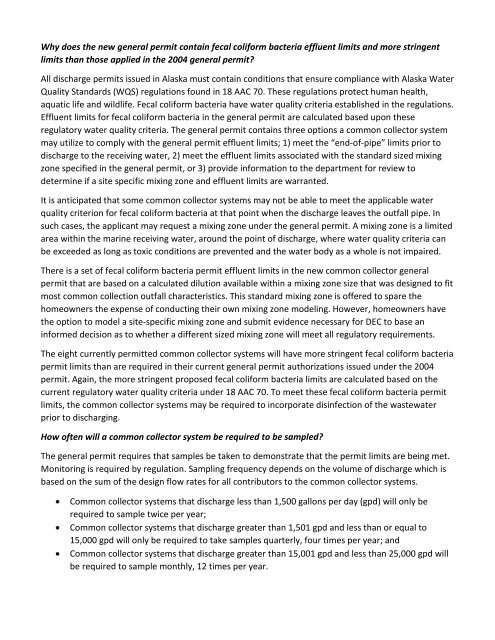COMMON COLLECTOR SYSTEMS FREQUENTLY ASKED QUESTIONS
Common_Collector_Systems_FAQ
Common_Collector_Systems_FAQ
Create successful ePaper yourself
Turn your PDF publications into a flip-book with our unique Google optimized e-Paper software.
Why does the new general permit contain fecal coliform bacteria effluent limits and more stringent<br />
limits than those applied in the 2004 general permit?<br />
All discharge permits issued in Alaska must contain conditions that ensure compliance with Alaska Water<br />
Quality Standards (WQS) regulations found in 18 AAC 70. These regulations protect human health,<br />
aquatic life and wildlife. Fecal coliform bacteria have water quality criteria established in the regulations.<br />
Effluent limits for fecal coliform bacteria in the general permit are calculated based upon these<br />
regulatory water quality criteria. The general permit contains three options a common collector system<br />
may utilize to comply with the general permit effluent limits; 1) meet the “end-of-pipe” limits prior to<br />
discharge to the receiving water, 2) meet the effluent limits associated with the standard sized mixing<br />
zone specified in the general permit, or 3) provide information to the department for review to<br />
determine if a site specific mixing zone and effluent limits are warranted.<br />
It is anticipated that some common collector systems may not be able to meet the applicable water<br />
quality criterion for fecal coliform bacteria at that point when the discharge leaves the outfall pipe. In<br />
such cases, the applicant may request a mixing zone under the general permit. A mixing zone is a limited<br />
area within the marine receiving water, around the point of discharge, where water quality criteria can<br />
be exceeded as long as toxic conditions are prevented and the water body as a whole is not impaired.<br />
There is a set of fecal coliform bacteria permit effluent limits in the new common collector general<br />
permit that are based on a calculated dilution available within a mixing zone size that was designed to fit<br />
most common collection outfall characteristics. This standard mixing zone is offered to spare the<br />
homeowners the expense of conducting their own mixing zone modeling. However, homeowners have<br />
the option to model a site-specific mixing zone and submit evidence necessary for DEC to base an<br />
informed decision as to whether a different sized mixing zone will meet all regulatory requirements.<br />
The eight currently permitted common collector systems will have more stringent fecal coliform bacteria<br />
permit limits than are required in their current general permit authorizations issued under the 2004<br />
permit. Again, the more stringent proposed fecal coliform bacteria limits are calculated based on the<br />
current regulatory water quality criteria under 18 AAC 70. To meet these fecal coliform bacteria permit<br />
limits, the common collector systems may be required to incorporate disinfection of the wastewater<br />
prior to discharging.<br />
How often will a common collector system be required to be sampled?<br />
The general permit requires that samples be taken to demonstrate that the permit limits are being met.<br />
Monitoring is required by regulation. Sampling frequency depends on the volume of discharge which is<br />
based on the sum of the design flow rates for all contributors to the common collector systems.<br />
• Common collector systems that discharge less than 1,500 gallons per day (gpd) will only be<br />
required to sample twice per year;<br />
• Common collector systems that discharge greater than 1,501 gpd and less than or equal to<br />
15,000 gpd will only be required to take samples quarterly, four times per year; and<br />
• Common collector systems that discharge greater than 15,001 gpd and less than 25,000 gpd will<br />
be required to sample monthly, 12 times per year.
















